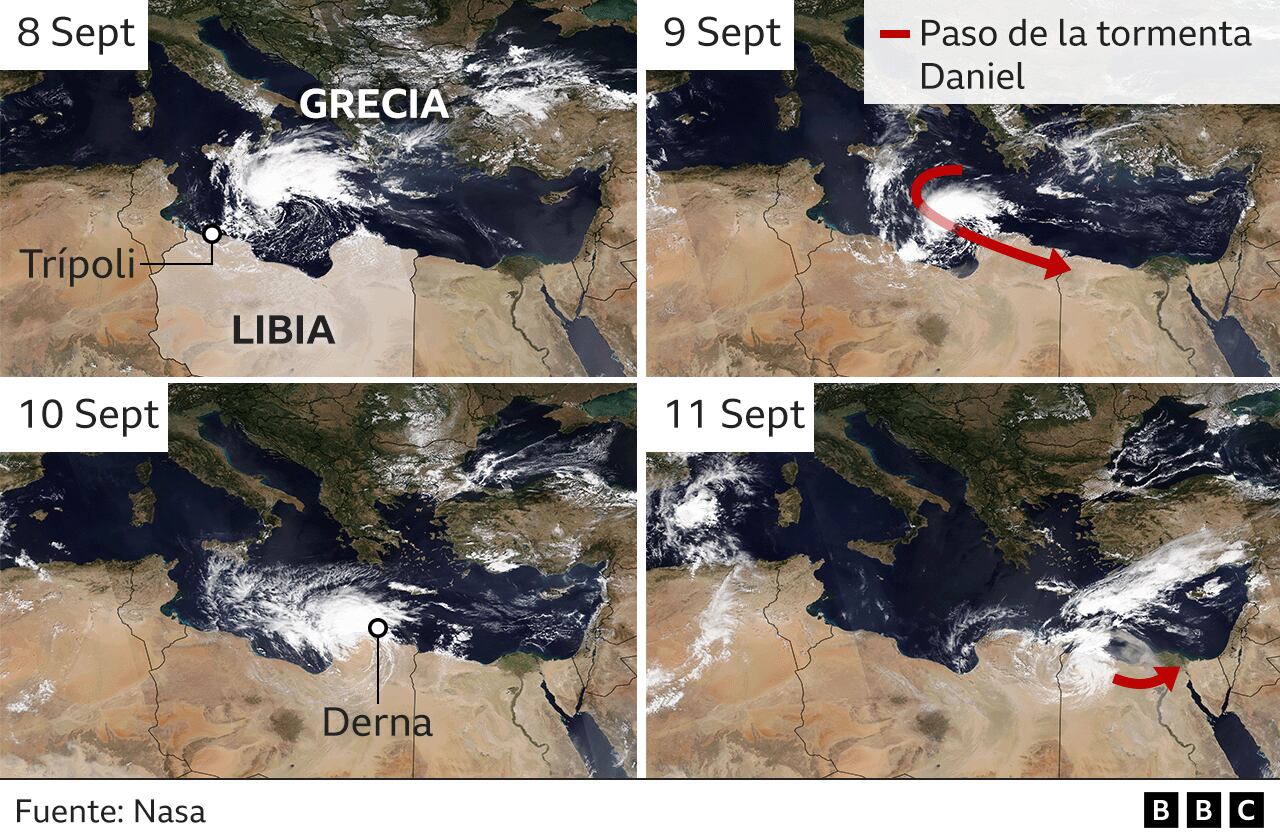More than 5,000 people died and thousands more are still missing after catastrophic floods swept away much of the port city of Derna, in Libya.
Entire neighborhoods disappeared into the sea when a tsunami-like torrent of water swept through the city.
LOOK: Images of the devastating floods that have left more than 3,000 dead and 10,000 missing in Libya
A Libyan journalist who spoke to survivors in the area said that The water had taken away entire families, and he described the situation as “worse than catastrophic.”
BBC Verify and visual journalism teams have been analyzing some of the reasons why the floods have caused such catastrophic damage in Derna.
Record rains
The water was brought by Storm Daniel, which hit Libya on Sunday.
Storm –a hurricane-like system that forms in the Mediterranean that is known as medicán– brought more than 40 mm of rain to the country’s northeast coast in a 24-hour period.
This is an immense amount of water for a region that normally receives just 1.5 mm of rain on average during the month of September.
The Libyan Meteorological Center says it is a record for rainfall.

It is still too early to confidently attribute the severity of the storms to rising global temperatures.
However, Climate change is believed to be increasing the frequency of stronger medications.
Professor Liz Stephens, an expert in climate risk and resilience at the University of Reading in the United Kingdom, says scientists know with a fair degree of certainty that climate change is supercharging the rainfall associated with these types of storms.
Two dams at their limit

The Wadi Derna River rises in the internal mountains of Libya, passes through the city of Derna and empties into the Mediterranean.
It remains dry most of the year, but these intense rains, unusual for the area, overwhelmed the capacities of two crucial dams and destroyed several bridges.
City residents, who had been ordered by local authorities to stay at home, They claimed to have heard an explosion before the city ended up underwater.
“The dams initially held the water, potentially releasing it all when they failed,” Professor Stephens said.
“The debris trapped in the flood waters surely increased its destructive power.”
Experts who have spoken to BBC Verify say it is too early to know whether the extreme rain was simply too much for the dams to hold, or whether the condition of the structures also played a role in the disaster.
Based on their observations, they believe that The dams were probably made of compacted earth and rocks.which are not as strong as concrete.
“These dams are susceptible to overtopping and, although concrete dams can survive such an event, it is usually difficult for a rock-filled one to do so,” says University of Exeter professor Dragan Savic, an expert in hydraulic engineering.
The first to fail appeared to be the upstream dam, according to structural engineer Andrew Barr.
Say what the water surely flowed down the rocky river until it reached the next dam, overflowing itresulting in the sudden and catastrophic flooding of the city that is trapped between the mountains and the sea.
As rescue efforts continue in the city, Libyan journalist Johr Ahr has been speaking to survivors in the city and told the BBC: “People are hearing babies crying under the ground and they don’t know how to get to them.”
“People use shovels to get the bodies out from under the ground, they are using their own hands. “They say it’s like the end of times,” Ali said.
With additional reporting by Mark Poynting, Peter Mwai and Jake Horton

Source: Elcomercio
I am Jack Morton and I work in 24 News Recorder. I mostly cover world news and I have also authored 24 news recorder. I find this work highly interesting and it allows me to keep up with current events happening around the world.

:quality(75)/cloudfront-us-east-1.images.arcpublishing.com/elcomercio/QHCSPHOKJZFH3N7TULLMC6TVQ4.jpg)

:quality(75)/cloudfront-us-east-1.images.arcpublishing.com/elcomercio/5QHXBF3WQFDJRAZZVWS3C6DV4M.jpg)
:quality(75)/cloudfront-us-east-1.images.arcpublishing.com/elcomercio/BUO6EJ5KRZHLFCS3FWMMF5HBPQ.jpg)
:quality(75)/cloudfront-us-east-1.images.arcpublishing.com/elcomercio/4XELV2MPRJBEFAQHHY3C43N2BY.jpg)
:quality(75)/cloudfront-us-east-1.images.arcpublishing.com/elcomercio/XRYCA3XOPRAYTDJS7CC6YA5P5I.jpg)
